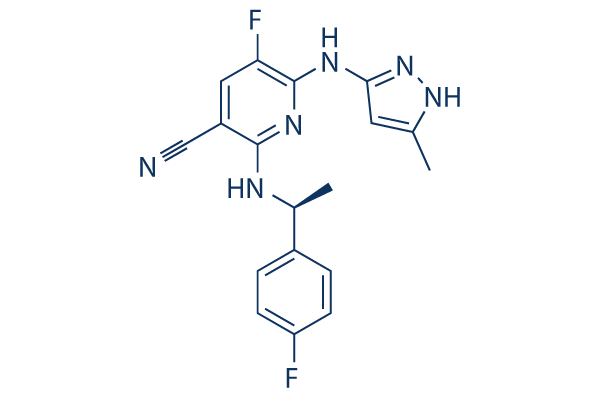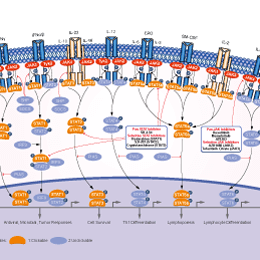
- Bioactive Compounds
- By Signaling Pathways
- PI3K/Akt/mTOR
- Epigenetics
- Methylation
- Immunology & Inflammation
- Protein Tyrosine Kinase
- Angiogenesis
- Apoptosis
- Autophagy
- ER stress & UPR
- JAK/STAT
- MAPK
- Cytoskeletal Signaling
- Cell Cycle
- TGF-beta/Smad
- DNA Damage/DNA Repair
- Compound Libraries
- Popular Compound Libraries
- Customize Library
- Clinical and FDA-approved Related
- Bioactive Compound Libraries
- Inhibitor Related
- Natural Product Related
- Metabolism Related
- Cell Death Related
- By Signaling Pathway
- By Disease
- Anti-infection and Antiviral Related
- Neuronal and Immunology Related
- Fragment and Covalent Related
- FDA-approved Drug Library
- FDA-approved & Passed Phase I Drug Library
- Preclinical/Clinical Compound Library
- Bioactive Compound Library-I
- Bioactive Compound Library-Ⅱ
- Kinase Inhibitor Library
- Express-Pick Library
- Natural Product Library
- Human Endogenous Metabolite Compound Library
- Alkaloid Compound LibraryNew
- Angiogenesis Related compound Library
- Anti-Aging Compound Library
- Anti-alzheimer Disease Compound Library
- Antibiotics compound Library
- Anti-cancer Compound Library
- Anti-cancer Compound Library-Ⅱ
- Anti-cancer Metabolism Compound Library
- Anti-Cardiovascular Disease Compound Library
- Anti-diabetic Compound Library
- Anti-infection Compound Library
- Antioxidant Compound Library
- Anti-parasitic Compound Library
- Antiviral Compound Library
- Apoptosis Compound Library
- Autophagy Compound Library
- Calcium Channel Blocker LibraryNew
- Cambridge Cancer Compound Library
- Carbohydrate Metabolism Compound LibraryNew
- Cell Cycle compound library
- CNS-Penetrant Compound Library
- Covalent Inhibitor Library
- Cytokine Inhibitor LibraryNew
- Cytoskeletal Signaling Pathway Compound Library
- DNA Damage/DNA Repair compound Library
- Drug-like Compound Library
- Endoplasmic Reticulum Stress Compound Library
- Epigenetics Compound Library
- Exosome Secretion Related Compound LibraryNew
- FDA-approved Anticancer Drug LibraryNew
- Ferroptosis Compound Library
- Flavonoid Compound Library
- Fragment Library
- Glutamine Metabolism Compound Library
- Glycolysis Compound Library
- GPCR Compound Library
- Gut Microbial Metabolite Library
- HIF-1 Signaling Pathway Compound Library
- Highly Selective Inhibitor Library
- Histone modification compound library
- HTS Library for Drug Discovery
- Human Hormone Related Compound LibraryNew
- Human Transcription Factor Compound LibraryNew
- Immunology/Inflammation Compound Library
- Inhibitor Library
- Ion Channel Ligand Library
- JAK/STAT compound library
- Lipid Metabolism Compound LibraryNew
- Macrocyclic Compound Library
- MAPK Inhibitor Library
- Medicine Food Homology Compound Library
- Metabolism Compound Library
- Methylation Compound Library
- Mouse Metabolite Compound LibraryNew
- Natural Organic Compound Library
- Neuronal Signaling Compound Library
- NF-κB Signaling Compound Library
- Nucleoside Analogue Library
- Obesity Compound Library
- Oxidative Stress Compound LibraryNew
- Plant Extract Library
- Phenotypic Screening Library
- PI3K/Akt Inhibitor Library
- Protease Inhibitor Library
- Protein-protein Interaction Inhibitor Library
- Pyroptosis Compound Library
- Small Molecule Immuno-Oncology Compound Library
- Mitochondria-Targeted Compound LibraryNew
- Stem Cell Differentiation Compound LibraryNew
- Stem Cell Signaling Compound Library
- Natural Phenol Compound LibraryNew
- Natural Terpenoid Compound LibraryNew
- TGF-beta/Smad compound library
- Traditional Chinese Medicine Library
- Tyrosine Kinase Inhibitor Library
- Ubiquitination Compound Library
-
Cherry Picking
You can personalize your library with chemicals from within Selleck's inventory. Build the right library for your research endeavors by choosing from compounds in all of our available libraries.
Please contact us at info@selleckchem.com to customize your library.
You could select:
- Antibodies
- Bioreagents
- qPCR
- 2x SYBR Green qPCR Master Mix
- 2x SYBR Green qPCR Master Mix(Low ROX)
- 2x SYBR Green qPCR Master Mix(High ROX)
- Protein Assay
- Protein A/G Magnetic Beads for IP
- Anti-Flag magnetic beads
- Anti-Flag Affinity Gel
- Anti-Myc magnetic beads
- Anti-HA magnetic beads
- Poly DYKDDDDK Tag Peptide lyophilized powder
- Protease Inhibitor Cocktail
- Protease Inhibitor Cocktail (EDTA-Free, 100X in DMSO)
- Phosphatase Inhibitor Cocktail (2 Tubes, 100X)
- Cell Biology
- Cell Counting Kit-8 (CCK-8)
- Animal Experiment
- Mouse Direct PCR Kit (For Genotyping)
- New Products
- Contact Us
AZ 960
JAK inhibitor
research use only
AZ 960 is a novel ATP competitive JAK2 inhibitor with IC50 and Ki of <3 nM and 0.45 nM, 3-fold selectivity of AZ960 for JAK2 over JAK3. AZ 960 induces apoptosis and growth arrest.

Chemical Structure
Molecular Weight: 354.36
Purity & Quality Control
Related Products
| Related Targets | JAK1 JAK2 JAK3 Tyk2 | Click to Expand |
|---|---|---|
| Related Products | AZD1480 WP1066 Momelotinib (CYT387) Filgotinib (GLPG0634) AT9283 Gandotinib (LY2784544) TG101209 Cerdulatinib (PRT062070) hydrochloride Pacritinib NVP-BSK805 2HCl WHI-P154 FLLL32 Decernotinib (VX-509) CEP-33779 Cerdulatinib (PRT062070) ZM 39923 HCl XL019 BMS-911543 Curcumol Solcitinib | Click to Expand |
| Related Compound Libraries | Kinase Inhibitor Library FDA-approved Drug Library Natural Product Library Tyrosine Kinase Inhibitor Library JAK/STAT compound library | Click to Expand |
Signaling Pathway
Mechanism of Action
| Targets |
|
|---|
In vitro |
||||
| In vitro | AZ960 also inhibits many kinases less than 50% at a concentration of 0.1 μM such as JAK3 (IC50=9 nM), TrkA, Aurora, and ARK5. In cells, AZ 960 inhibits the phosphorylation of STAT5 in TEL-JAK2 cells with an average IC50 of 15 nM and exhibits 15-30 -fold sensitivity for TEL-JAK2-driven STAT5 phosphorylation compared with cell lines driven by other JAK kinase family members (TEL-JAK1, -JAK3, and -TYK2). AZ 960 shows potent activity in inhibiting the proliferation of the TEL-JAK2, -JAK1, -JAK3, and -Tyk2 cell lines with GI50 values of 25 nM, 230 nM, 279 nM, and 214 nM, respectively. Moreover, AZ 960 also potently inhibits SET-2 cell proliferation with an average GI50 of 33 nM by reducing both STAT3 and STAT5 phosphorylation levels. [1] AZ 960 causes growth arrest and apoptosis of human T-cell lymphotropic virus type 1, HTLV-1pe 1, HTLV-1LV-1osis of human T-cSET-2 cell proliferation witBcl-xL by small interfering RNA potentiates anti-proliferative effects of AZ 960 in MT-1 cells. [2] A recent study shows that AZ 960 leads to significant inhibition of the clonogenic growth and induction of apoptosis of freshly isolated AML cells from patients. [3] | |||
|---|---|---|---|---|
| Kinase Assay | Enzyme Biochemical Assay and Kinase Profiling | |||
| Inhibition studies of AZ 960 are performed using a recombinant JAK2 kinase (amino acids 808–1132) at a peptide (Tyk2 peptide) concentration of 100 nM and an ATP concentration of 15 μM. Concentrations of AZ 960 ranging from 0.003 μM to 30 μM are used. The mode of inhibition and inhibition constant (Ki) of AZ960 against JAK2 kinase are further evaluated by inhibition kinetics. Specifically, a series of JAK2-catalyzed reactions are set up in HEPES buffer (75 mM, pH 7.3) with a fixed concentration of peptide (FL-Ahx-IPTSPITTTYFFFKKK-COOH), and varied concentrations of ATP and AZ 960. The progress of each reaction is subsequently monitored by the Caliper LC3000 system, and the initial velocity of each reaction is extracted from the corresponding reaction time course. To define the mode of inhibition, initial velocities are plotted against corresponding ATP concentrations using Lineweaver-Burk plots and the characteristic convergence of the lines on the y axis demonstrates the competitiveness of AZ 960 to ATP. Initial inspection of Ki using the Michealis-Menten equation revealed that AZ960 is a tight-binding inhibitor of JAK2. AZ960 is profiled against 83 kinases at three inhibitor concentrations (0.01 μM, 0.10 μM, and 1.0 μM). | ||||
| Cell Research | Cell lines | SET-2 and TEL-JAK Ba/F3 cells | ||
| Concentrations | 0.016-10 μM | |||
| Incubation Time | 48-72 hours | |||
| Method | Cellular proliferation is evaluated using the fluorometric/colorimetric BIOSOURCE AlamarBlue Assay and read in the Spectra Max Gemini EM microplate reader. SET-2 cells are plated at 20,000 cells/well, TEL-JAK2 Ba/F3 cells at 2000 cells/well, and all other TEL-JAKs at 5000 cells/well in 96-well plates. Cells are treated with AZ 960 24 hours after plating and grown for 72 hours for SET-2 and 48 hours for TEL-JAK Ba/F3 cells. Following the indicated growth period Alamar Blue (10 μL/well) is added, cells are incubated at 37 °C in 5% CO2 for 2 hours, and fluorescence is measured at 545 (excitation) and 600 nm (emission). Data are normalized to percent of the control, and GI50 values (the concentration that causes 50% growth inhibition) are calculated using Xlfit4 version 4.2.2 for Microsoft Excel. | |||
References |
|
Chemical Information
| Molecular Weight | 354.36 | Formula | C18H16F2N6 |
| CAS No. | 905586-69-8 | SDF | Download SDF |
| Synonyms | N/A | ||
| Smiles | CC1=CC(=NN1)NC2=C(C=C(C(=N2)NC(C)C3=CC=C(C=C3)F)C#N)F | ||
Storage and Stability
| Storage (From the date of receipt) | |||
|
In vitro |
DMSO : 71 mg/mL ( (200.36 mM) Moisture-absorbing DMSO reduces solubility. Please use fresh DMSO.) Ethanol : 3 mg/mL Water : Insoluble |
Molecular Weight Calculator |
|
In vivo Add solvents to the product individually and in order. |
In vivo Formulation Calculator |
|||||
Preparing Stock Solutions
Molarity Calculator
In vivo Formulation Calculator (Clear solution)
Step 1: Enter information below (Recommended: An additional animal making an allowance for loss during the experiment)
mg/kg
g
μL
Step 2: Enter the in vivo formulation (This is only the calculator, not formulation. Please contact us first if there is no in vivo formulation at the solubility Section.)
% DMSO
%
% Tween 80
% ddH2O
%DMSO
%
Calculation results:
Working concentration: mg/ml;
Method for preparing DMSO master liquid: mg drug pre-dissolved in μL DMSO ( Master liquid concentration mg/mL, Please contact us first if the concentration exceeds the DMSO solubility of the batch of drug. )
Method for preparing in vivo formulation: Take μL DMSO master liquid, next addμL PEG300, mix and clarify, next addμL Tween 80, mix and clarify, next add μL ddH2O, mix and clarify.
Method for preparing in vivo formulation: Take μL DMSO master liquid, next add μL Corn oil, mix and clarify.
Note: 1. Please make sure the liquid is clear before adding the next solvent.
2. Be sure to add the solvent(s) in order. You must ensure that the solution obtained, in the previous addition, is a clear solution before proceeding to add the next solvent. Physical methods such
as vortex, ultrasound or hot water bath can be used to aid dissolving.
Tech Support
Answers to questions you may have can be found in the inhibitor handling instructions. Topics include how to prepare stock solutions, how to store inhibitors, and issues that need special attention for cell-based assays and animal experiments.
Tel: +1-832-582-8158 Ext:3
If you have any other enquiries, please leave a message.
* Indicates a Required Field






































